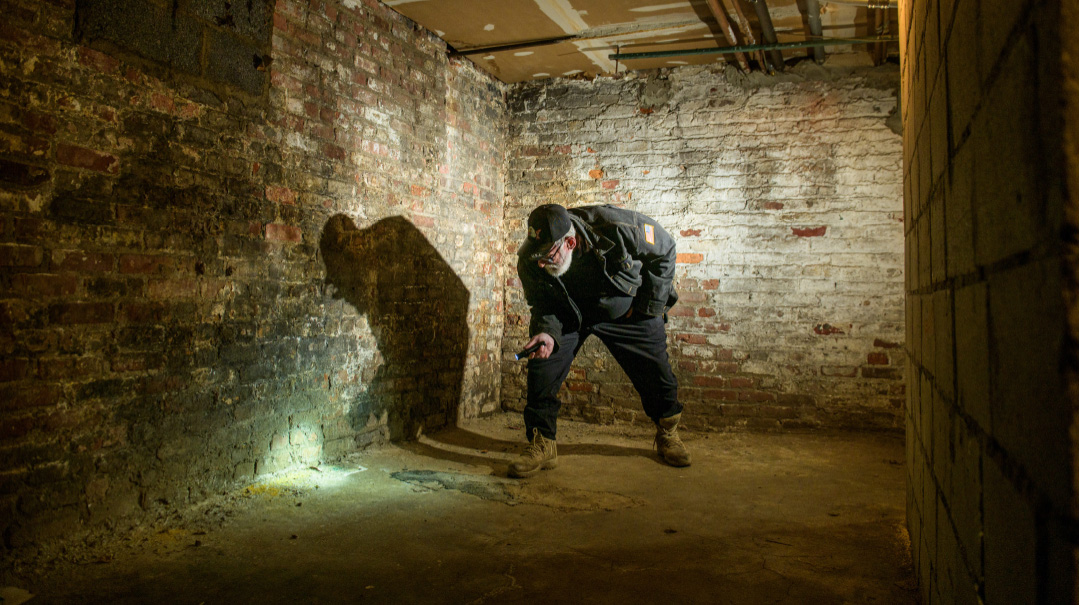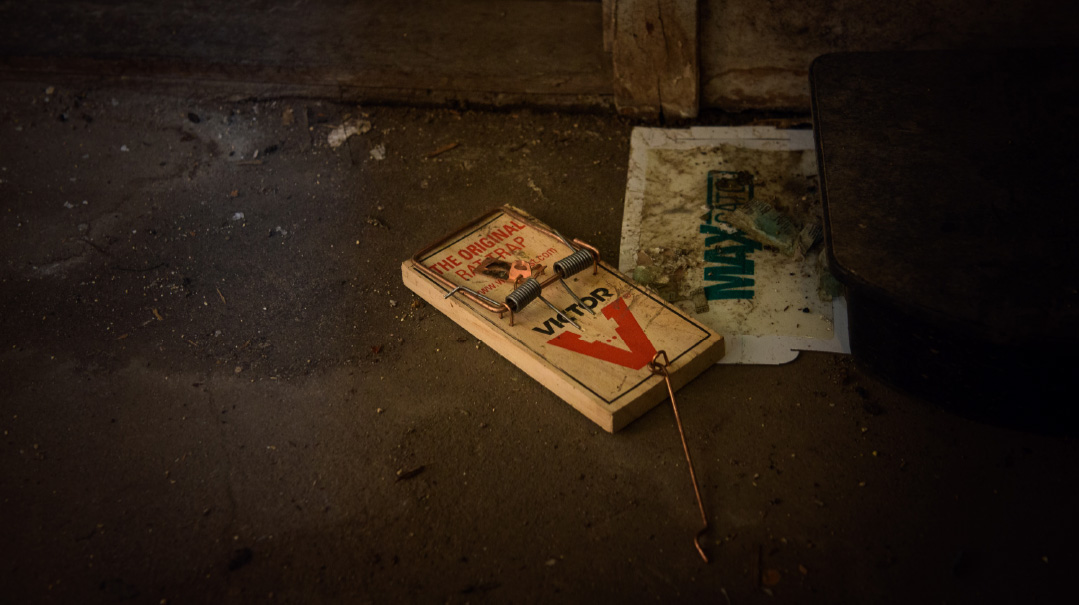Rat Race

Now that Mayor Eric Adams had declared all-out war on rats, one heimish exterminator is waiting for them to enlist his help

Photos: Naftoli Goldgrab
A
re you bloodthirsty, swashbuckling, and have a killer instinct? If yes, you could have a future as the chief exterminator of New York City’s estimated between two and eight million rats.
Mayor Eric Adams took office setting out to solve three goals to make New York a “livable city”: by “fighting crime, fighting inequality, and fighting rats” – symbols of New York’s ongoing and out-of-control downward spiral. Now he’s looking for a rat murderer, and he’s willing to pay up to $170,000 for the right candidate.
Adams’s administration posted a job listing recently looking for a “rat czar,” a candidate to lead the city’s long-running battle against rats. The official job title is “director of rodent mitigation,” and the ideal qualifier should be “highly motivated and somewhat bloodthirsty, determined to look at all solutions from various angles, including improving operational efficiency, data collection, technology innovation, trash management, and wholesale slaughter,” according to the listing, which described New York’s rats as “cunning, voracious, and prolific,” who are “legendary for their survival skills.”
It might sound like a holiday joke, but the job is actually quite daunting, if not impossible. New York City leaders have been trying to control the multi-million rat population for over a century, with negligible results.
Local authorities in New York have long admitted that eliminating rats from the city is unrealistic, but have made various efforts over the years to control the rodents, with only marginal success. It used to be that after receiving complaints of rat infestation, officials would send exterminators to attack the scene with traps and rat poison – but that was often too little, too late. In recent years though, the city began to focus on preventive measures, although city rats managed to survive a multimillion-dollar effort under former mayor Bill de Blasio that focused on better trash pickups, housing inspections in targeted neighborhoods, and landlord fines.
A decade ago, municipal authorities announced a plan for mass sterilization of the city’s rats, using a chemical to neutralize the reproductive systems of female rats, who birth a new litter of up to a dozen pups every two months. The city also launched a program to use dry ice to suffocate rats in their hiding spots, and Adams, when he was Brooklyn borough president, once demonstrated a trap that used a vat of poisoned soup to drown rats lured by the scent of food.
New York City’s department of health already has an expert rodent biologist — renowned rodentologist Robert Corrigan, an office for pest control, and a citywide rodent task force. Still, the problem is worse than ever despite the past decade’s efforts: Since the beginning of 2022, New York has seen its worst infestation since rat sighting records were made public in 2010 – partly because of the abundance of food waste with pandemic-induced outdoor dining, and a Department of Sanitation policy relaxing the requirement for residential buildings to keep their waste in containers. Mayor Adams believes someone who can coordinate all the existing efforts will finally do the trick.
Mordy Fogel hopes the new “rat czar” will enlist his help, although he’s more than a bit cynical that this new position (which he actually applied for but didn’t meet the educational requirements) will become another bureaucratic bungle. An exterminator with more than a quarter century of experience, including working on some of the short-lived municipal initiatives, he’s even come up with a detailed plan to curb the city’s rat population once and for all.
To get a handle on how bad rat infestation really is, I accompanied Fogel around on his job.

Mordy Fogel is in an ongoing battle with cellar rats. “We close holes, the rats open them, we close them again. Really, the way to take care of this problem is not the way I’m doing it”
A Warm Home
In New York, if you want to see a rat, you just have to head to the nearest subway station and peer at the tracks. Or you can go to some neighborhoods — such as Bushwick in Brooklyn — and a rat colony will visit you.
Mordy Fogel is the owner of Squish Pest Control (“as in squish a bug,” he tells me, adding by way of explanation that “'squash’ was taken already”).
We arrive at his first job of the day, an apartment building near Boro Park. There are 16 units there, all heimish people and mostly families of kollel yungeleit. It’s right across from a prominent yeshivah and looks just like any of the other dozens of similar buildings in the neighborhood.
Fogel asks the photographer to hide his equipment until we enter the basement.
“The people who live here all know there’s an issue, but thank G-d they don’t know the extent of it,” he explains. “I’ve been working on it for a year already. We come by every month. We close holes, the rats open them, we close them again. It’s an ongoing battle.”
We walk into the basement and I smell a rat. Seriously.
The basement is piled with succah paraphernalia, such as schach and panels. Fogel shines his flashlight around to survey the results of the past month, settling on a corner. “They’re having parties over here,” he mutters to himself. The floor is littered with hundreds of rat droppings. In some places, the rats have eaten through the concrete, chomping the floor into a pile of gravel.
“We only used wire mesh to cover the holes,” Fogel’s worker tells me, speaking in a Slavic accent. “They can eat up to a quarter inch of concrete. They have teeth like steel.”
The floor is strewn with glue traps, each one full of rat droppings. “This is not for the rats,” the exterminator says. “They slide right out of them. This is for the water bug situation.” Indeed, water bugs are all over the place, and larger than the average bug.
From the evidence, I estimate that a colony of dozens of rats calls the place home. And this neighborhood is not even on the city’s list of most infested — such as Chinatown in Manhattan, Bedford-Stuyvesant in Brooklyn, and the Grand Concourse in the Bronx — nor is it near a subway station, which are notoriously overrun by the repulsive vermin.
The room is heavy with the scent of a dead rat. Fogel looks around and suddenly bends down and picks up a corpse, holding it by the tail with his bare hands. “See? This one just died,” he says. I cringe. Fogel drops it and continues rushing through the rooms in the basement. “I want to see if I can show you a live one scurrying across,” he calls after me. Okay, I guess I need that for the story, but every fiber of my being hopes it doesn’t happen.
“The way to take care of this problem is not the way I’m doing it,” Fogel admits. “I’m just putting on a Band-Aid. The right way to do it is for me to be here every day for two weeks straight, continuously putting out bait. Then I’d stick a shmatteh in the hole, and if after three days you see the shmatteh hasn’t moved, you know you’ve wiped them out and we close up the hole.”
“But these people can’t afford it,” he adds. “They’re all kollel yungeleit.”
Burrow Park
Rats want a place where they can hide, Fogel says. They look for rubble or a bushy area where humans rarely go, they find it comfortable and will make it their home. They reproduce at a startlingly rapid rate, they can crawl through a hole the size of a quarter (their skulls are made of separate bones instead of one plate so their heads can change shape and squeeze through), and can live treading water for three days.
Rats, more than possums and raccoons, are the worst type of urban pest. They carry up to 18 diseases, including salmonella, E. coli, bubonic plague, and Leptospira. A strain of the Covid virus was found last month in New York City rats. Given the close quarters shared by rats and New York City residents, the rat scourge could potentially be a recipe for a public health nightmare. The NYC Health Department recommends that people bitten by a rat seek immediate medical attention, as bacteria from the rat’s teeth can cause tetanus as well as rat bite fever, which can be fatal.
The Big Apple is without doubt a rat heaven. There are a million places to get comfy, where humans hardly disturb and where there is an abundance of food available within a few hundred feet. Rats only require an ounce of food and water a day to live, and curbside garbage disposal from residences and restaurants contribute greatly to their sustenance.
Estimates of how many rats live within the city’s confines range from as few as two million (the most definitive study) to as many 33 million, and this basement fits the bill for a rat abode. Although it has since been cleaned up, the rats have fully established themselves here, wandering regularly around the building’s four stories and spooking residents.
The first thing Fogel did was get the residents to clear out the basement.
“For many years,” Fogel tells me, “I had a problem getting into the storage rooms. The common areas I had access to, but once the rats got inside the private storage rooms, they crawled under the doors and started burrowing into the ground. I couldn’t get to where the burrows were to put poison there – the residents had their stuff piled up to the ceiling. The residents fought me for a long time, until new management came in and told them they had to get rid of their things.”

No Place in This City
Fogel expects any rat czar the city hires to do the same — find out where the rats are and move in for the kill. But he is under no illusions. City biologist Bobby Corrigan, he tells me, is considered one of the country’s greatest rodent experts, yet he threw his hands up in frustration after a bout of negotiations with former mayor Bill de Blasio.
When de Blasio became the mayor in 2014, the Pest Management Association, the official lobbying group for the industry, sent him a letter with an offer to help him become the guy who eliminated rats from the city. The association proposed providing the city with 200 veteran exterminators, each with a minimum of 20 years of experience. “Within two years,” the association promised, “you’ll see that we will cut down on the rat population.”
When several weeks passed with no response, the association tried again, figuring that the new mayor didn’t want to spend so much money on it. This time they halved the number of proposed exterminators, saying that 100 experienced pest control men could greatly ease the rodent problem.
There was still no response. The association tried a third time, offering 50 of the city’s exterminators. That got the de Blasio administration’s attention. The mayor then issued a press release announcing a crackdown on rats, saying he would be putting 150 men on the street to combat the scourge.
Those 150 men, the association soon learned to its dismay, were ticket agents, not exterminators. The mayor’s method of dealing with rats was through steep fines for homeowners who were caught with rat burrows on their property.
“Until today,” says Fogel, who was on all three lists of experienced exterminators offered to de Blasio, “this is how the city fights rats — by fining the property owner.”
With Adams, Fogel had his hopes a bit higher. Jessica Tisch, his administration’s sanitation commissioner, has popularized the slogan, “The rats don’t run this city — we do.” T-shirts and other merchandise with the phrase are being sold, and a press release claimed that “ever since this fall’s major announcement about the latest efforts to take back our streets from the Murine Menace, [the] phrase has been on every New Yorker’s lips.”
“I hate rats, as you know,” Adams said last month. “I’m scared of them and when I see one, I think about it all day. So, yes, I am fixated on killing rats.” Gothamist, a local news website, made a video mashup of Adams saying the word “rat” or “rats” more than 80 times since mid-October alone.
“When we started killing them in Borough Hall, some of the same folks that are criticizing us now called me a murderer because I was killing rats,” Adams said, referring to his vat experiment in his previous position as Brooklyn borough president. “Well, you know what? We’re going to kill rats. Rats have no place in this city.”
But for New Yorkers to reclaim their streets, they can’t rely on the Pied Piper to lead the rats away: Only a mass kill-off will work. Complaints to the city hotline about rats increased by 70 percent in the first eight months of 2022 compared to 2020. Last year, likely due to the extensive cleaning on account of the Covid pandemic, the number of calls dropped dramatically to fewer than 3,000. But they came roaring back this year, with more than 21,500 sightings reported.
A “rat information portal” set up by the city to report sightings tells me that the “map is currently undergoing updates and data is only current up to 1/8/2020. Please stay tuned while we enhance our system.”
The city advertisement appeared to be in response to that.
“Do you have what it takes to do the impossible?” it asked. “A virulent vehemence for vermin? A background in urban planning, project management, or government? And most importantly, the drive, determination and killer instinct needed to fight the real enemy — New York City’s relentless rat population?”
But when Fogel clicked on the job application and saw the requirements for a college education and knowledge of computers but not necessarily extermination, he realized the job would probably be more political than hands-on.
“We might not be computer literate, but at the end of the day we’re exterminators,” Fogel says, hoping the new position won’t be another political hack job. “I don’t want to see another situation where the city will have someone to point a finger at as an excuse, saying something like, ‘Look, we hired Joe Smith and he’s doing the best he can and we still can’t solve the problem.’”
He blames the city’s politically powerful environmentalist lobby, who advocates against using chemicals that are toxic enough to kill rats.
“We’re trained, we’re professional, we’re licensed, we know how to use the stuff,” he says. “But every year, they make more regulations to take things away from us. Either you trust us or you don’t.”
Two main concerns voiced by environmentalists are that the toxic chemicals may dissolve into the earth, and that birds of prey that are protected species, such as falcons or eagles, might ingest the poison together with the dead rats they’ll eat.
“Agreed, we don’t want to kill off other wildlife,” Fogel says, “but there’s a limit on how much you can do just to protect birds. What about humans?”
Environmentalists, Fogel charges, wants to limit exterminators to gas and dry ice, which can cost thousands of dollars to purchase and license and be too costly for many exterminators.
Furry Friends
Ironically, the one requirement of the city ad that Fogel does not possess is a virulence for vermin. In fact, he has several rats as pets.
“Rats happen to be extremely intelligent animals,” he reveals. “For the fun of it, I’ve gone to pet shops and bought rats, and within a matter of three days I’ve had my kids train them to sit on a shoulder and eat from a hand.”
More than Mordy Fogel found his calling, his calling found him. He has a fascination with animals and loves the challenge of going after them. He mostly gets calls to get rid of raccoons, mice, possums and rats, as well as an occasional snake. The snake calls are usually for harmless garter snakes, but he once had to corral a poisonous snake that escaped its cage, and another time had a call for a boa constrictor which was left behind when a tenant moved. “I took it home and kept it as a pet for a year,” he says.
Fogel studies the habits of his prey obsessively, but even he is sometimes surprised by their antics — such as the time he was called to a home in East New York and heard scratching from the inside of a kitchen cabinet. He opened the cabinet door and saw a rat sitting there. “It jumped over my head, clear across the room — it must have leaped at least ten feet in the air — it landed and just kept going,” he says. “I wasn’t ready for that. I didn’t know they could jump that far.” He’s also seen rats attack and chase away cats, the opposite scenario of what we generally expect.
Like in almost every area, the extermination industry is also now using some advanced technology. For example, as Fogel sets out rat traps and bait stations, he’ll be monitoring them in real time, getting a notification on his phone when a rat enters a bait station.
After a nerve wracking few minutes, we finally step out of the rat-nest and Fogel begins poking around the grass outside to look for any new burrows — a giveaway that the rodents are growing bolder. He finds none.
For the residents of this building though, life goes on in an ordinary way above ground, most of them oblivious to the underground tenants living it up in the pipes and under the floors. A yungerman pulls into the driveway. A woman stops to ask if she can park in a spot. Another woman walks up the stairs to her apartment, laden down with groceries. Fogel lowers his voice — he doesn’t want people to know how badly infested the basement is. Rats, after all, can’t be fought one building at a time. They must be eradicated through a citywide extermination effort.
And if the city doesn’t want to get the rats too comfortable, it should reconsider the way it handles trash. All those bags of yummy rat food put out on the street every night offsets the hard work of poisoning them or drowning them. Back in the day, New York City required the use of metal trash cans in order to avoid rats, but today’s collection system is a rat’s heaven.
What, I question him, would you do if you were appointed the rat czar?
He thinks for a minute – actually, he’s been thinking about it since entering the industry over two dozen years ago.
“Step one,” he says, “I would hire 200 exterminators with a minimum of 20 years of experience. There are good technicians out there who know where the burrows are and know what to do. And stop giving tickets to people. Fire the 150 ticket agents and hire that many exterminators. Walk around the city, map out where the most complaints are and start wiping the rats out.” —
Rachel Ginsberg contributed to this report.
(Originally featured in Mishpacha, Issue 942)
Oops! We could not locate your form.







